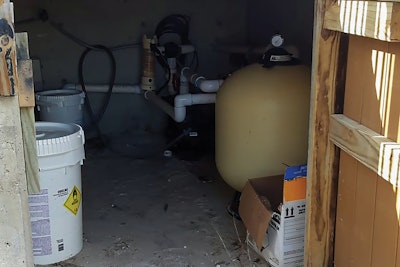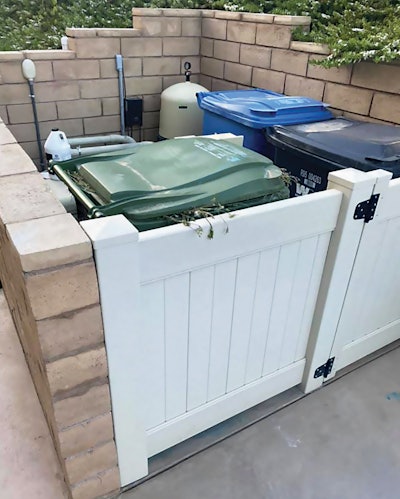
Have you ever looked at the equipment pad at a new build and thought, "What were these tommyknockers thinking?!"
Next thing you do — you cut out the equipment and replumb the pad. Why? Because it looks like Mario and Luigi put this together for their next Maze Mayhem video game.
 Paul Rodriguez has to share space with trash and recycling bins on this equipment pad, buried in the back of his customer's backyard and surrounded by brick walls.Photo courtesy Paul Rodriquez
Paul Rodriguez has to share space with trash and recycling bins on this equipment pad, buried in the back of his customer's backyard and surrounded by brick walls.Photo courtesy Paul Rodriquez
This is an all-too-common occurrence. The homeowner is confused and upset because, "Everything is brand new!" In response, I honestly don't know what to say. I sure as shexpletive am not going to trash the people who installed the pool, but they do have my back against the wall. All I know is if I cannot correct the pain points right off the bat, I'm not taking the job unless it's at a premium; even then, this pool may have me hating life.
Every pool on my route has to be serviceable. I'd rather fix the problems now instead of having to deal with them later as they inevitably rear their ugly heads. If the homeowner rejects the repairs part of the bid or significant problems cannot be remedied, I move on. I don't need the headache.
 Access to the waterline is another issue to consider in design. Here, Jason of N.J.-based Blue Dolphin Natural Water Systems holds on to the ankles of his colleague as he removes a safety cover waterfall cable system eyebolt.Photo courtesy Michael Walsh
Access to the waterline is another issue to consider in design. Here, Jason of N.J.-based Blue Dolphin Natural Water Systems holds on to the ankles of his colleague as he removes a safety cover waterfall cable system eyebolt.Photo courtesy Michael Walsh
At this point, I'm sure somebody is shouting, "Don't you like money?!" Yes, I do. But I also don't like being consumed by repugnance each week as I pull up to a house. The financial gain has to significantly exceed the challenges associated with the account to be considered worthwhile. Sometimes, you can't get there; other times, that number just doesn't exist.
The truth is that some pool builders, in their quest for the jaw-dropping Instagram shot, might accidentally build pools that are all sizzle and no steak. You've seen 'em: the sheer descent that defies gravity, the Salvador Daliesque shape inspired by a hypnagogic hallucination, the vanishing edges that disappear into a private lagoon, and even some of these lazy rivers. Sure, they're head-turners, but depending on who did the job, beneath that shiny mosaic tile can lurk a plumbing nightmare.
Architectural, recreational, freeform, cocktail, infinity — so many types to choose from — but is the homeowner aware of the potential for dead spots within that exquisite shape? You know what I mean, those areas within the pool where the water is slower moving, treated less often, and filtered less frequently. They are hotbeds for cyanobacteria (black algae) and diatoms (mustard algae). Even in regular old rectangular gunite pools, you find lethargic flow beneath skimmers, in the corners of step areas or behind ladders.
"You can always tell if a pool builder was a service tech before building pools by looking at the pad." —Kevin B.
I'm not knocking builders in general, just the bad apples that build the no-go showboats or cheap out and then wash their hands of it. Certainly every sector of our industry has its sloppy dimwits and dolts, like every industry. Trust me, I know a lot of Shmendrik pool service techs out there that really floc things up on the reg — maybe another article. So, my friends who build brilliantly, know this article is not about you.
So why do these people bring such things to life? It reminds me of this Dr. Ian Malcolm quote (Jurassic Park, Michael Crichton): "Your scientists were so preoccupied with whether or not they could, they didn't stop to think if they should." These builders put all their effort into making a pool look like it belongs in a magazine, forgetting that it actually has to function as a pool. In an episode with Dan Lenz and Kelli Clancy from the "Talking Pools Podcast" hit the nail on the head: "Does anyone check these award-winning pools to see if they are, you know, legitimate, practical pools?"
This, of course, is not limited to the 'Wow Factor' warriors! Unserviceable swimming pools scatter the nation like buckshot. It need not be a $500K build at a million-dollar home; you see them at your everyday $40K-plus pools. These things are everywhere, like freckles on the ass of the industry.
It's usually somebody too focused on cheap and fast. Think FLEX PIPE on a $200K pool! It saves time and money upfront, but, for the unknowing pool owner, it is a looming wound that will be a considerable drain (pun intended) on their wallet and sanity. Leaks, repairs, replacements — suddenly, that luxury pool is a financial sinkhole.
But mainly, they just ignore the fact that the pool will need to be cleaned. For instance, a pool wall where rock features sit atop and extend beyond the coping can only be brushed or scrubbed from within the pool. If the builder of that feature had to clean it a few times, this problem would disappear. Or maybe the solution is for a pool tool manufacturer to take this opportunity to create the 'bent handle ergonomic telepole.'
THE OVERPACKED PAD
Some builders simply want to put as much equipment as possible on the smallest pad you can lay. They think it saves money. And it certainly does. For them. And you're left wondering how they managed to make it all fit, like looking under the hood of a clown car. Here's the deal: tiny, tight spaces are not fun, and no one should have to work in them.
Give these things room to breathe; they work hard, respect the equipment space bubble. Even something as simple as cleaning a filter can become a significant pain in the butt if you have to do it in a tight space. Remember how easy it was to work on the motor of a car back in the 70s? You could get right up under the hood and easily access everything. That's what we need.
Plumbing that's a labyrinth — these are the things that turn pool maintenance into a weekly battle. Sometimes, it looks like the installer was trying to set a world record for the number of 90s used on a single pad. The folks at Guinness Book would be proud. Guess what? Time for the Sawzall! Otherwise, if left as is, this loopty-loop design would exponentially increase the resistance the pump will face (Total Dynamic Head (TDH)). This friction energy rises as the water travels through the pipes, encountering resistance at every turn.
Keep in mind that TDH is not a suction-side-only dilemma. The archaic PVC Alpe d'Huez on the effluent is also a substantial contributing factor. The effort required by the pump to push water through the system is influenced dramatically by all of this. That creates the need for additional rpms and a pump that is challenging to prime and destined to cavitate.
As a pool professional, you are responsible for refusing customer design change requests that will not align with the build's infrastructure. If the customer asks you to install the manifold or valves on the suction side of the pump at hip level while the pump remains ground level on the pad because they don't like to bend over, you should say no. Sadly, this design is becoming a trend because folks are giving in to customers demands. No one needs the money that badly to completely abandon their level of technical acumen and create the hydraulic disaster this entails. But, yet, they exist.
"Everyone hates tearing apart a $100,000-plus masterpiece to fix a leak caused by a $5 part." —Johnny C.
The additional wear and tear on the equipment increases with the higher Total Dynamic Head (TDH), which can shorten a pool pump's life. Aside from damaging the pump's internal components, cavitation will also cause a slight vibration, which can cause glue joints to rattle and fail.
Fountains, grottos, sheer descents — please include automation for pH control and explain to the pool owner that, over their pool's lifetime, they will be using more acid than the people at Woodstock.
What the heck, now's as good a time as any — every builder installing a salt cell, please ignore the capacity listing and go one size up on the cell. This will enable the swg to hit the target chlorine level quicker, reducing the run time and lessening the bubbling off of Nitrogen gas and the formation of caustic soda. If that's not something you're willing or able to do, please install an acid feed system of some sort. It's the right thing to do.
Most pool builders build pools that are more than just eye candy. We must get everyone to ditch the impractical designs and the quick-fix mentality. It's okay to talk a homeowner out of a design or away from a feature if it doesn't work on a specific design. Focus on creating pools that are as functional as they are beautiful, and they will be a joy for a homeowner to own, not a constant source of stress or battle with their pool service tech. Pools that stand the test of time are always better than Instagram likes.
I firmly believe that the most effective way for a pool builder to grasp the essence of creating service-friendly pools is to spend time in the trenches of pool service before donning the builder's cap. Working in pool service provides a unique perspective, offering firsthand experience dealing with technicians' day-to-day challenges.
It allows you to anticipate issues and create designs that prioritize accessibility and reliability. It's an investment in knowledge that pays off, ensuring that the pools constructed meet the eye and stand the test of time with minimal service-related headaches.
This article first appeared in the February 2024 issue of AQUA Magazine — the top resource for retailers, builders and service pros in the pool and spa industry. Subscriptions to the print magazine are free to all industry professionals. Click here to subscribe.












































